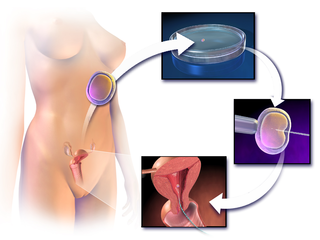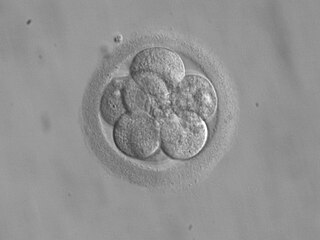Prevalence

Globally, about 10% of infertile couples have unexplained infertility. [7]
Unexplained infertility is infertility that is idiopathic in the sense that its cause remains unknown even after an infertility work-up, usually including semen analysis in the man and assessment of ovulation and fallopian tubes in the woman. [1] It is usually an exercise in excluding all possible causes before making a diagnosis, however the age of the female partner as well as the duration of infertility are often the most scrutinized characteristics of any infertility case. [2]
In unexplained infertility abnormalities are likely to be present but not detected by current methods. Possible problems could be that the egg is not released at the optimum time for fertilization, that it may not enter the fallopian tube, sperm may not be able to reach the egg, fertilization may fail to occur, transport of the zygote may be disturbed, or implantation fails. It is increasingly recognized that egg quality is of critical importance and women of advanced maternal age have eggs of reduced capacity for normal and successful fertilization. Also, polymorphisms in folate pathway genes could be one reason for fertility complications in some women with unexplained infertility. [3] Aberrant reproductive immunology such as decreased maternal immune tolerance towards the embryo may also be a possible explanation. However, a growing body of evidence suggests that epigenetic modifications in sperm may be partially responsible. [4] [5]

Globally, about 10% of infertile couples have unexplained infertility. [7]
Potential methods in unexplained infertility include oral ovarian stimulation agents (such as clomifene citrate, anastrozole or letrozole) as well as intrauterine insemination (IUI), intracervical insemination (ICI) and in vitro fertilization (IVF).
In women who have not had previous treatment, ovarian stimulation combined with IUI achieves approximately the same live birth rate as IVF. [8] On the other hand, in women who have had previous unsuccessful treatment, IVF achieves a live birth rate approximately 2–3 times greater than ovarian stimulation combined with IUI. [8]
IUI and ICI has higher pregnancy rates when combined with ovarian stimulation in couples with unexplained infertility, for IUI being 13% unstimulated and 15% stimulated, and for ICI being 8% unstimulated and 15% stimulated. However, the rate of twin birth increases substantially with IUI or ICI combined with ovarian stimulation, for IUI being 6% unstimulated and 23% stimulated, and for ICI being 6% unstimulated and 23% stimulated. [9]
According to NICE guidelines, oral ovarian stimulation agents should not be given to women with unexplained infertility. [10] Rather, it is recommended that in vitro fertilization should be offered to women with unexplained infertility when they have not conceived after two years of regular unprotected sexual intercourse. [10] IVF avails for embryo transfer of the appropriate number of embryos to give good chances of pregnancy with minimal risk of multiple birth.
A review of randomized studies came to the result that IVF in couples with a high chance of natural conception, as compared to IUI/ICI with or without ovarian stimulation, was more effective in three studies and less effective in two studies. [9]
There is no evidence for an increased risk of ovarian hyperstimulation syndrome (OHSS) with IVF when compared with ovarian stimulation combined with IUI. [8]
Prognosis in unexplained infertility depends on many factors, but can roughly be estimated by e.g. the Hunault model, which takes into account female age, duration of infertility/subfertility, infertility/subfertility being primary or secondary, percentage of motile sperm and being referred by a general practitioner or gynecologist. [9] [11]

In vitro fertilisation (IVF) is a process of fertilisation where an egg is combined with sperm in vitro. The process involves monitoring and stimulating a woman's ovulatory process, removing an ovum or ova from their ovaries and letting sperm fertilise them in a culture medium in a laboratory. After the fertilised egg (zygote) undergoes embryo culture for 2–6 days, it is implanted in a uterus, with the intention of establishing a successful pregnancy.
Infertility is the inability of a person, animal or plant to reproduce by natural means. It is usually not the natural state of a healthy adult, except notably among certain eusocial species. It is however the healthy state of a human child or other young offspring, for they have not yet undergone puberty, the body's start of reproductive capacity.

Artificial insemination (AI) is the deliberate introduction of sperm into a female's cervix or uterine cavity for the purpose of achieving a pregnancy through in vivo fertilization by means other than sexual intercourse or in vitro fertilisation. It is a fertility treatment for humans, and is common practice in animal breeding, including dairy cattle and pigs.

Assisted reproductive technology (ART) includes medical procedures used primarily to address infertility. This subject involves procedures such as in vitro fertilization (IVF), intracytoplasmic sperm injection (ICSI), cryopreservation of gametes or embryos, and/or the use of fertility medication. When used to address infertility, ART may also be referred to as fertility treatment. ART mainly belongs to the field of reproductive endocrinology and infertility. Some forms of ART may be used with regard to fertile couples for genetic purpose. ART may also be used in surrogacy arrangements, although not all surrogacy arrangements involve ART. The existence of sterility will not always require ART to be the first option to consider, as there are occasions when its cause is a mild disorder that can be solved with more conventional treatments or with behaviors based on promoting health and reproductive habits.

Embryo transfer refers to a step in the process of assisted reproduction in which embryos are placed into the uterus of a female with the intent to establish a pregnancy. This technique, may be used in humans or in animals, in which situations the goals may vary.
Fertility medications, also known as fertility drugs, are medications which enhance reproductive fertility. For women, fertility medication is used to stimulate follicle development of the ovary. There are very few fertility medication options available for men.
Zygote intra fallopian transfer (ZIFT) is an infertility treatment used when a blockage in the fallopian tubes prevents the normal binding of sperm to the egg. Egg cells are removed from a woman's ovaries, and in vitro fertilised. The resulting zygote is placed into the fallopian tube by the use of laparoscopy. The procedure is a spin-off of the gamete intrafallopian transfer (GIFT) procedure. The pregnancy and implantation rates in ZIFT cycles are 52.3 and 23.2% which were higher than what was observed in IVF cycles which were 17.5 and 9.7%.
Egg donation is the process by which a woman donates eggs to enable another woman to conceive as part of an assisted reproduction treatment or for biomedical research. For assisted reproduction purposes, egg donation typically involves in vitro fertilization technology, with the eggs being fertilized in the laboratory; more rarely, unfertilized eggs may be frozen and stored for later use. Egg donation is a third party reproduction as part of assisted reproductive technology.

A hydrosalpinx is a condition that occurs when a Fallopian tube is blocked and fills with serous or clear fluid near the ovary. The blocked tube may become substantially distended giving the tube a characteristic sausage-like or retort-like shape. The condition is often bilateral and the affected tubes may reach several centimeters in diameter. The blocked tubes cause infertility. A Fallopian tube filled with blood is a hematosalpinx, and with pus a pyosalpinx.
Ovulation induction is the stimulation of ovulation by medication. It is usually used in the sense of stimulation of the development of ovarian follicles to reverse anovulation or oligoovulation.

Fertility clinics are medical clinics that assist couples, and sometimes individuals, who want to become parents but for medical reasons have been unable to achieve this goal via the natural course. Clinics apply a number of diagnosis tests and sometimes very advanced medical treatments to achieve conceptions and pregnancies.

Human oocyte cryopreservation is a procedure to preserve a woman's eggs (oocytes). This technique has been used to enable women to postpone pregnancy to a later date – whether for medical reasons or for social reasons. Several studies have proven that most infertility problems are due to germ cell deterioration related to aging. The uterus remains completely functional in most elderly women, which implies that the factor which needs to be preserved is the woman's eggs. The eggs are extracted, frozen and stored. The intention of the procedure is that the woman may choose to have the eggs thawed, fertilized, and transferred to the uterus as embryos to facilitate a pregnancy in the future. The procedure's success rate varies depending on the age of the woman, and ranges from 14.8 percent to 31.5 percent.
Controlled ovarian hyperstimulation is a technique used in assisted reproduction involving the use of fertility medications to induce ovulation by multiple ovarian follicles. These multiple follicles can be taken out by oocyte retrieval for use in in vitro fertilisation (IVF), or be given time to ovulate, resulting in superovulation which is the ovulation of a larger-than-normal number of eggs, generally in the sense of at least two. When ovulated follicles are fertilised in vivo, whether by natural or artificial insemination, there is a very high risk of a multiple pregnancy.
Poor ovarian reserve is a condition of low fertility characterized by 1): low numbers of remaining oocytes in the ovaries or 2) possibly impaired preantral oocyte development or recruitment. Recent research suggests that premature ovarian aging and premature ovarian failure may represent a continuum of premature ovarian senescence. It is usually accompanied by high FSH levels.
Fertility preservation is the effort to help cancer patients retain their fertility, or ability to procreate. Research into how cancer, ageing and other health conditions effect reproductive health and preservation options are growing. Specifically sparked in part by the increase in the survival rate of cancer patients.
Pregnancy rate is the success rate for getting pregnant. It is the percentage of all attempts that leads to pregnancy, with attempts generally referring to menstrual cycles where insemination or any artificial equivalent is used, which may be simple artificial insemination (AI) or AI with additional in vitro fertilization.

Fertility testing is the process by which fertility is assessed, both generally and also to find the "fertile window" in the menstrual cycle. General health affects fertility, and STI testing is an important related field.
The history of in vitro fertilisation (IVF) goes back more than half a century. In 1959 the first birth in a nonhuman mammal resulting from IVF occurred, and in 1978 the world's first baby conceived by IVF was born. As medicine advanced, IVF was transformed from natural research to a stimulated clinical treatment. There have been many refinements in the IVF process, and today millions of births have occurred with the help of IVF all over the world.
Endometriosis and its complications are a major cause of female infertility. Endometriosis is a dysfunction characterized by the migration of endometrial tissue to areas outside of the endometrium of the uterus. The most common places to find stray tissue are on ovaries and fallopian tubes, followed by other organs in the lower abdominal cavity such as the bladder and intestines. Typically the endometrial tissue adheres to the exteriors of the organs, and then creates attachments of scar tissue called adhesions that can join adjacent organs together. The endometrial tissue and the adhesions can block a fallopian tube and prevent the meeting of ovum and sperm cells, or otherwise interfere with fertilation, implantation and, rarely, the carrying of the fetus to term.
Repeated Implantation failure (RIF) is the failure of the embryo to implant onto the side of the uterus wall following IVF treatment. Regularly, this happens at 6–7 days after conception and involves the embedding of the growing embryo into the mothers uterus and a connection being formed. A successful implantation can be determined by using an ultrasound to view the sac which the baby grows in, inside the uterus.